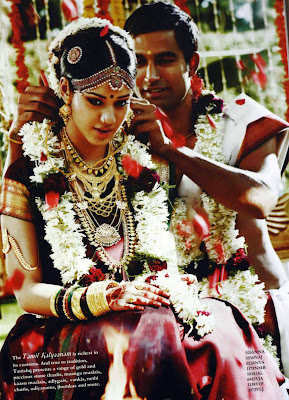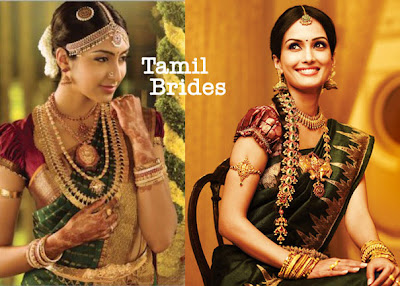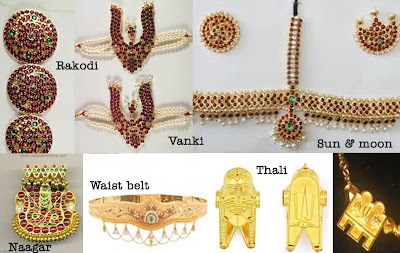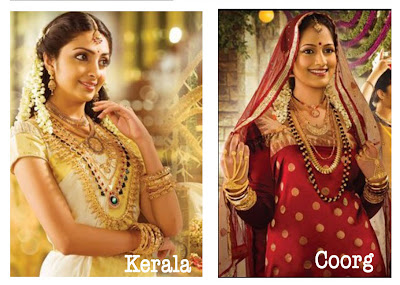In Hindu culture, marriages are conducted to resemble the wedding of Lord Rama and Sita. Even today, people sing the song “Sita kalyana vibokame” (Sita’s marriage celebrations) during weddings and hence the bride is decked up in every possible way to resemble the mythical Princess of Mithila. The range of South Indian Bridal Jewellery is simply mind boggling. Tamil, Telugu and Kanadigas mostly wear Temple jewelry, Keralities wear gold and Maharashtrians wear pearls and gold during wedding. Silver is usually not worn and is considered auspicious only in the form of vessels, lamps etc.
 |
| The groom ties the thali around the bride’s neck |
Summary of South Indian Bridal Jewellery from head to toe
Hair /head accessories: a center focal with a tie up on two sides. The discs are called sun and the moon (symbolizing the blessings of celestial beings). At the back (crown of the head) is Rakodi worn to protect the brain and fresh flowers surround it. The lower portion of the braid is decorated with gold plated/stone studded snake motifs (naagar) in decreasing proportion while some wear discs similar to the rakodi. Some others wear fresh flowers or floral shapes (either as screws or combs) and the braid ends in a silk tassel. A bindi adorns the forehead.

In some communities (both tamil and telugu) Bride and the groom wear an amulet tied with a yellow string on the forehead. Brides from Maharashtra wear mundavalya – strings of pearls tied horizontally across the forehead in a cascade from the temples down to the shoulders, framing the face.
Earring: Traditonal Jumka (basket earrings) with a chain are worn
Nose ring: some brides get their nose pierced just before the wedding and are gifted with a diamond nose pin. In Maharashtra, the much celebrated nath or Circular barbells is worn
Neck: A collar necklace or addigai with stones is worn close to the neck. This is followed by a chain, gold bead or pearl necklace with a heavy flat pendant. The Coin necklace or Kasu malai follows it. Coorgi women wear a long chain or gold and black beads. Malayalee (kerala) bride The bride also adorns various gold necklaces with designs inspired by temple borders and interspersed with colored glass stones. Maharashtrian women wear netted necklaces and popular motifs for pendants include fish, lotus, conch, bitter gourd and serpents.
Mangalsutra/ Thali/Thirumangalyam/Muhurthamani : Considered the most sacred of all jewelries for a married woman, it is the the Hindu equivalent of the wedding ring and is tied by the groom around the bride’s neck as a sign of commitment. The thali could have the design of the Conch and disc (Shangu – Chakram), tulasi madam ( holy basil plant), shiva lingam (Phallus) or Goddess Meenakshi represented as per family traditions. As the Mangal Sutra lands on the middle of the bride’s chest, it symbolizes that her man has occupied the whole of her being through her heart. Coins, coral beads or doomed bezels are also worn along with the center piece in the thali.
In kanadiga and Maharashtrian communities, a chain of black beads with a pendant is worn as the mangal sutra and is called the Muhurtamani (mani a gold piece with the sun and moon representing the delicate balance a bride is supposed to maintain between the husband’s and her maternal family.)

Waist/hip belt: A waist belt (gold plated with stones) or Oddiyanam is worn to keep the saree in place. Also before the Thali tying ceremony when the bride is presented with a new saree (9 yards in case of Brahmins) A belt made of reed grass is then tied around the bride’s waist by the groom or his sister and signifies bonding her with the new family.
Hands : A carved/embossed/stone studded armlet (called Vanki or angada) shaped like a snake or floral arch is worn. The Finger ring which the maternal uncle buys for the bride is the most important. In Kerala there is a custom of wearing gold rings with the spouse’s name engraved on it.
Bangles are considered very auspicious and it is customary that the brides wears atleast one pair of new bangles. In the south, bangles are predominantly gold with glass bangles to match the colour of their sarees. In Maharashtra green bangles are considered a sign of marital bliss. Also during the pre wedding ceremonies a holy thread (kappu) is tied on the brides wrists to ward off all evil spirits. It symbolizes a kind of protective armor for the bride.This is removed only when the couple reach the bridegroom’s house after the wedding
Leg: Some brides wear anklets but it is not customary to do so.
Toe ring: Metti: After the Thali is tied and offerings are made to the holy fire, The bridegroom holds the bride’s left toe and helps her to tread on a grindstone by taking seven steps (Saptapadhi) while taking 7 vows and is symbolic of the solid rock foundation for the union.The the bride’s aunt (mother’s brother’s wife – usually married with children) slips in the silver toe rings to enhance the bride’s fertility and offers her advice to start a family.
Well then its a wrap bridal posts on Indian (Hindu) jewelry. Jains & Sikhs wear similar ornaments with maybe different names. What Indian Christians, Muslims, Parsis wear would be slightly different and would be talked about in a separate post, later in the series. Nomadic and Tribal jewelry is completely different and hence is excluded from these two posts….Here is the post on the North Indian section, in case you have missed it.
Hope you all enjoyed reading it..looking forward for more contributions to the series… especially from Europe and US
cheers





Leave a Reply